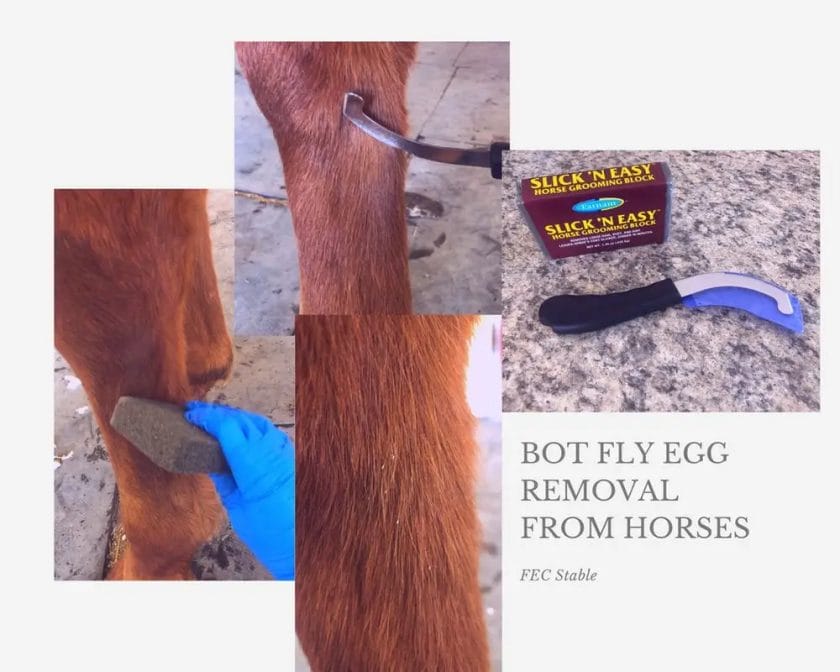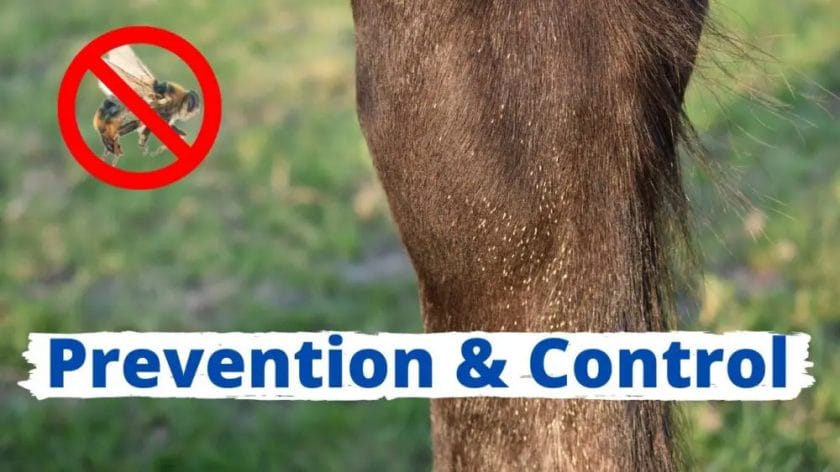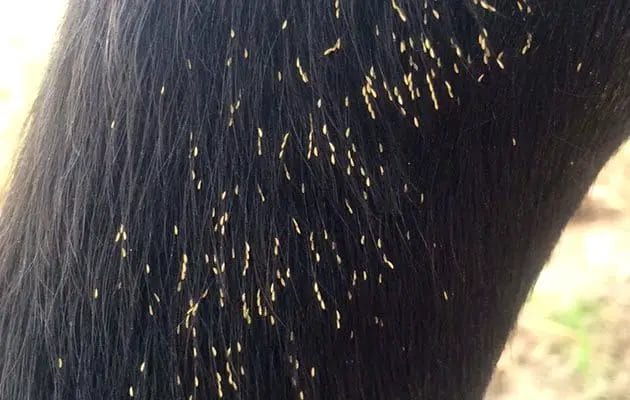Are you struggling with bot eggs on your horse? Removing bot eggs is a crucial part of equine grooming and maintaining your horse’s health. These yellow, oval-shaped eggs can be found on the horse’s legs, mane, and tail, and are laid by bot flies. In this guide, we will provide you with effective methods to safely and efficiently remove bot eggs from your horse, ensuring their well-being and preventing potential health issues.
When it comes to removing bot eggs, it’s essential to use the right tools and techniques. Start by wearing gloves to protect your hands and prevent the spread of any potential infections or irritations. Using a bot knife or scraper specifically designed for this purpose, gently and carefully scrape the eggs off the horse’s coat.
Always approach the process with patience and care, as horses can be sensitive to grooming. Begin from the top of the horse’s body and work your way down, paying close attention to areas where bot eggs are commonly found, such as the legs, underbelly, and mane.
Remember, bot eggs are incredibly sticky, so it’s crucial to clean your tools regularly to prevent reinfestation. After each scraping session, wipe the bot knife or scraper with a cloth and remove any remaining eggs or debris. This will ensure a more effective and thorough cleaning process.
Once you have successfully removed the bot eggs from your horse, it’s important to dispose of them properly

Best Practices to Safely Remove Bot Eggs from Your Horse
Bot eggs are small, yellowish, oval-shaped eggs that are laid by bot flies on a horse’s coat. These eggs can be quite irritating to horses and can lead to health issues if not removed properly. In this section, we will discuss the best practices for safely removing bot eggs from your horse.
1. Gather the necessary tools
Before you begin the process of removing bot eggs, make sure you have all the necessary tools ready. This includes a bot knife or bot egg scraper, a soft brush or grooming mitt, and a bucket for collecting the eggs.
2. Choose the right time
It is important to choose the right time to remove bot eggs from your horse. Ideally, you should do this during the warmer part of the day when the eggs are easier to remove. This is because the eggs become more tacky and adhesive in cooler temperatures, making them harder to remove.
3. Start with a thorough grooming session
Before you begin removing the bot eggs, give your horse a thorough grooming session. Use a soft brush or grooming mitt to remove any loose dirt or debris from your horse’s coat. This will make it easier to spot the bot eggs and ensure a more effective removal process.
4. Use a bot knife or bot egg scraper
Once you have completed the grooming session, it’s time to start removing the bot eggs. Take the bot knife or bot egg scraper and gently scrape the eggs off your horse’s coat. Be careful not to apply too much pressure to avoid injuring your horse’s skin.
5. Collect the eggs in a bucket
As you scrape off the bot eggs, collect them in a bucket to prevent them from falling back onto your horse or onto the ground. This will help to minimize the risk of re-infestation and ensure a thorough removal process.
6. Dispose of the eggs properly
After you have finished removing the bot eggs, it is important to dispose of them properly. Do not throw them into pastures or areas where horses graze, as this can lead to re-infestation. Instead, seal the bucket containing the eggs and dispose of them in a secure manner.
7. Repeat the process as necessary
Depending on the severity of the bot infestation, you may need to repeat the process of removing bot eggs multiple times. It is recommended to perform this task regularly to prevent further infestation and ensure the well-being of your horse.
8. Monitor your horse’s coat
After removing the bot eggs, it is important to monitor your horse’s coat for any signs of re-infestation. Check regularly for new eggs and promptly remove them to prevent the bot larvae from hatching and causing potential health issues.
9. Consult with a veterinarian
If you are unsure about the process of removing bot eggs or if your horse shows any signs of discomfort or complications, it is always best to consult with a veterinarian. They can provide further guidance and recommend appropriate treatments if needed.
In summary, safely removing bot eggs from your horse is essential for their well-being. By following these best practices, you can effectively remove bot eggs and minimize the risk of re-infestation. Regular monitoring and proper grooming will help ensure a healthy and happy horse.

Proven Methods for Removing Bot Eggs and Protecting Your Horse
Bot flies can be a nuisance for horses, as they lay their eggs on the horse’s hair. These eggs, known as bot eggs, can cause irritation and discomfort for the horse if left untreated. Fortunately, there are several proven methods for removing bot eggs and protecting your horse from these pesky flies.
1. Manual Removal
One of the most effective ways to remove bot eggs from your horse is through manual removal. To do this, you will need a bot knife or a grooming tool with serrated edges. Gently scrape the bot eggs off the horse’s hair, taking care not to apply too much pressure and injuring the horse’s skin. It’s important to be thorough in your approach, as even a few remaining eggs can hatch and continue the life cycle of the bot flies.
2. Hot Water Treatment
Another method to remove bot eggs is through hot water treatment. This method involves using warm water to soften the eggs, making them easier to remove. Start by wetting a sponge or a cloth with hot water (not scalding) and gently rub it over the bot eggs. The warm water will help loosen the eggs, allowing you to wipe them off with ease. Be cautious when using hot water, ensuring it’s not too hot to harm the horse’s skin.
3. Commercial Bot Egg Removal Products
There are various commercial products available specifically designed for removing bot eggs from horses. These products usually come in the form of sprays or shampoos that contain ingredients to dissolve and remove bot eggs. Follow the instructions provided by the manufacturer and apply the product to the affected areas as directed. Remember to wear gloves and avoid contact with your eyes and mouth when using these products.
4. Regular Grooming
Regular grooming practices can be instrumental in preventing the buildup of bot eggs on your horse. Brushing your horse’s coat regularly helps to remove any eggs before they have a chance to hatch. Use a grooming brush or a curry comb to remove any loose hair and debris that may harbor bot eggs. Additionally, keeping your horse’s stable clean and free from manure can also help reduce the chances of bot egg infestation.
5. Fly Control Measures
Implementing effective fly control measures can significantly reduce the presence of bot flies and, therefore, the number of bot eggs laid on your horse. Use fly repellents and fly masks to protect your horse from bot flies. Fly traps and insecticides can also be employed in and around your horse’s living areas to keep the fly population at bay. Additionally, consider using fly sheets or blankets for extra protection.
6. Consult with Your Veterinarian
If you’re unsure about how to properly remove bot eggs or if your horse seems to be experiencing discomfort, it’s always best to consult with your veterinarian. They can provide guidance on the best methods for your specific situation and recommend any additional treatments or medications if necessary.
In summary, removing bot eggs from your horse and protecting them from bot flies is crucial for their well-being. Manual removal, hot water treatment, commercial products, regular grooming, fly control measures, and consulting with your veterinarian are all proven methods to keep your horse bot egg-free and happy.

Expert Tips for Removing Bot Eggs to Ensure Your Horse’s Well-being
As a responsible horse owner, it is essential to be knowledgeable about the various parasites that can affect your horse’s health. One such parasite is the bot fly, which lays its eggs on your horse’s coat. These eggs, commonly known as bot eggs, can be a nuisance and potentially harm your horse if not removed promptly. In this section, we will provide you with expert tips on how to effectively remove bot eggs to ensure your horse’s well-being.
Understanding Bot Eggs
Before delving into the removal process, it is vital to understand what bot eggs are and how they can impact your horse. Bot flies are pesky insects that lay their eggs on the hair of horses, typically in areas such as the legs, belly, and mane. These eggs are yellowish or white in color and have a sticky outer layer, allowing them to adhere firmly to the hair.
Once the eggs are laid, they hatch into larvae, which are capable of causing significant damage to your horse’s digestive system if ingested. The larvae burrow into your horse’s mouth and attach themselves to the lining of the stomach or intestines, resulting in discomfort, irritation, and potential health issues.
Removing Bot Eggs
Now that we understand the potential risks associated with bot eggs, let’s explore expert tips on how to effectively remove them:
- Use a Bot Egg Knife: A specialized bot egg knife is designed to safely scrape off bot eggs from your horse’s coat. These knives have serrated edges that help in loosening and detaching the eggs without causing harm to your horse’s skin. It is essential to use proper technique and caution while using a bot egg knife to prevent accidental injuries to both you and your horse.
- Grooming Tools: Regular grooming with a stiff-bristled brush or a bot egg removal tool can help dislodge bot eggs from your horse’s coat. When using these tools, make sure to brush in the direction of hair growth to avoid causing any discomfort to your horse. Additionally, using a grooming mitt or glove can be effective in removing loose bot eggs from the coat.
- Warm Water Soak: Soaking the areas affected by bot eggs in warm water can help soften the eggs and make them easier to remove. After soaking, gently rub the eggs with a soft cloth or sponge to dislodge them from the hair. Ensure that the water is not too hot to avoid scalding your horse’s skin.
- Bot Egg Removal Products: There are various commercial products available specifically formulated to remove bot eggs. These products typically come in the form of sprays or shampoos that effectively dissolve the sticky outer layer of the eggs, making them easier to remove. Follow the product instructions carefully when using these products.
Preventing Reinfestation
In addition to removing bot eggs, it is crucial to take preventive measures to minimize the risk of reinfestation:
- Regular Grooming: Maintaining a consistent grooming routine helps to identify and remove bot eggs before they can hatch. Regularly brush your horse’s coat, paying close attention to areas where bot eggs are commonly found.
- Implementing Fly Control Measures: As bot flies are the source of bot eggs, implementing effective fly control measures can significantly reduce the risk of reinfestation. Use fly repellents, fly masks, and fly sheets to protect your horse from these insects.
- Proper Hygiene: Clean and sanitize your horse’s living quarters regularly to eliminate bot fly larvae present in the environment. Ensure that manure is promptly removed and disposed of properly.
Summary
Removing bot eggs from your horse’s coat is crucial for their well-being and health. By following these expert tips, you can effectively remove bot eggs and minimize the risk of reinfestation. Remember to use proper tools and techniques, regularly groom your horse, and implement preventive measures to ensure your horse stays healthy and free from the harmful effects of bot eggs.
Quick and Easy Steps to Remove Bot Eggs from Your Horse
Bot eggs are small, yellowish-white, sticky eggs that are laid by bot flies on the legs, shoulders, and other areas of horses. These eggs can be quite irritating for your horse and may lead to skin infections if not removed. It is important to regularly check and eliminate bot eggs from your horse’s coat to ensure their well-being. In this section, we will guide you through some quick and easy steps to effectively remove bot eggs from your horse.
Step 1: Gather the necessary tools
Before you begin, make sure you have the following tools on hand:
- Gloves
- Bot knife or bot egg removal comb
- Bucket or container to collect the eggs
- Soft brush or sponge
- Water
- Bucket or hose for rinsing
Step 2: Put on gloves
Wearing gloves will protect your hands from any potential irritants or bacteria present on the bot eggs.
Step 3: Identify and target the bot eggs
Carefully inspect your horse’s coat, paying close attention to the legs, shoulders, and other areas where bot eggs typically attach. Bot eggs are often found in clusters and have a distinctive yellowish-white color.
Step 4: Use a bot knife or bot egg removal comb
Take the bot knife or bot egg removal comb and gently scrape the eggs off your horse’s coat. Start at the base of the egg and work your way towards the tip. Be cautious not to dig too deep or scrape the skin, as this may cause discomfort or injury to your horse.
Step 5: Collect the removed eggs
As you remove the bot eggs, collect them in a bucket or container. This prevents the eggs from falling back onto your horse or contaminating the surrounding area.
Step 6: Brush or rinse the area
After removing the bot eggs, use a soft brush or sponge to gently brush away any residue or remaining egg fragments. Alternatively, you can rinse the area with water using a hose or bucket to ensure thorough cleaning.
Step 7: Dispose of the eggs
Properly dispose of the collected bot eggs. Make sure to seal the container and discard it in a secure location away from other horses to prevent reinfestation.
Step 8: Repeat as necessary
Bot flies lay eggs throughout the warmer months, so it is important to regularly check your horse for bot eggs and remove them as soon as possible. Repeat this process as needed to keep your horse free from bot eggs.
In Summary
Removing bot eggs from your horse is an essential part of their grooming routine. By following these quick and easy steps, you can effectively remove bot eggs from your horse’s coat, ensuring their comfort and preventing potential skin infections. Remember to wear gloves, use the appropriate tools, and dispose of the eggs properly. Regularly checking and removing bot eggs will help keep your horse happy and healthy.
FAQs
1. How can I remove bot eggs from my horse?
To remove bot eggs from your horse, you can use a bot knife or bot egg scraper to carefully scrape them off the horse’s hair. Make sure to use gentle and precise strokes to avoid injuring the horse’s skin. It’s important to regularly check and remove bot eggs to prevent infestation and maintain your horse’s health.
2. Are bot eggs harmful to my horse?
Bot eggs are not harmful to your horse in their early stages, but if left untouched, they can hatch into larvae and pose a risk to your horse’s well-being. The larvae can cause irritation, sores, and intestinal issues. Regularly removing bot eggs helps prevent these problems and keeps your horse healthy.
3. How often should I check and remove bot eggs from my horse?
It is recommended to check and remove bot eggs from your horse every 1-2 weeks during the warmer months when bot flies are active. However, the frequency may vary depending on your horse’s exposure to these pests. Regular grooming and thorough inspection will help you identify and remove bot eggs in a timely manner.
Conclusion
In conclusion, removing bot eggs from horses is a crucial aspect of their grooming and overall health. By regularly removing these eggs, horse owners can prevent discomfort, irritation, and potential health issues. Effective methods such as using a bot knife, grooming tool, or specialized bot egg removal products can be employed to safely and efficiently remove bot eggs from the horse’s coat. Additionally, maintaining a clean and hygienic environment, along with proper stable management, can play a significant role in preventing bot infestations. Remember, early detection and consistent removal of bot eggs are key to ensuring the well-being and comfort of your beloved horses.
